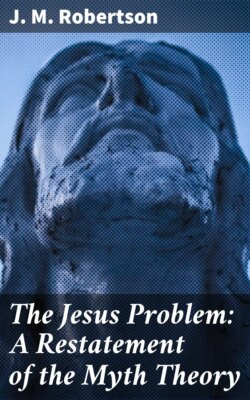Читать книгу The Jesus Problem: A Restatement of the Myth Theory - J. M. Robertson - Страница 14
На сайте Литреса книга снята с продажи.
§ 7. The Cross
ОглавлениеTable of Contents
It is not at all certain, and it is not probable, that in the earlier stages of the myth the cross as such was prominent. Early crucifixion was not always a nailing of outstretched hands in the cross form, but often a hanging of the victim by the arms, tied together at the wrists, with or without a support to the body at the thighs.100 The stauros was not necessarily a cross: it might be a simple pile or stake. In the Book of Acts (v, 30) Peter and the Apostles are made to speak of Jesus “whom ye slew, hanging him on a tree.” This was in itself a common sacrificial mode; and all sacrificial traditions are more or less represented in the New Testament compilation.
But there was an irresistible compulsion to a divinizing of the cross as of the victim. Ages before the Christian era the symbol had been mystic and sacrosanct for Semites, for Egyptians, for Greeks, for Hindus; and the Sacred Tree of the cults of Attis, Dionysos, and Osiris lent itself alike to many symbolic significances.101 The cross had reference to the equinox, when the sacred tree was cut down; to the victim bound to it; to the four points of the compass; to the zodiacal sign Aries, thus connected with the sacrificial lamb;102 and to the universe as symbolized in the “orb” of the emperor, with the cross-lines drawn on it. The final Christian significance of the cross is a composite of ideas associated with it everywhere, from Mexico to the Gold Coast, in both of which regions it was or is a symbol of the Rain-God.103 The Dravidian victim, the deified sacrifice, was as-it-were crucified;104 as was a victim in a Batak sacrifice, where, as on the Gold Coast, the St. Andrew’s-cross form is enacted.105 The commonness of some such procedure in African sacrificial practice points to its general antiquity.
It would appear, too, that in the mysteries of the Saviour Gods not only a crucified aspect of the God but a simulation of that on the part of the devotees was customary. Osiris was actually represented in crucifix form;106 and in the ritual the worshipper became “one with Osiris,” apparently by being “joined unto the sycamore tree.”107 When, then, in the Epistle to the Galatians108 we find “Paul” addressing the converts as “those before whose eyes Jesus Christ was openly set forth (προεγράφη) crucified,” and declaring of himself:109 “I bear in my body the marks of the Lord Jesus,” we are at once pointed to the Syrian practice of stigmata, which appears to connect with both Osirian and Christian usage. In his remarkable account of the life of the sacred city of Hierapolis—a microcosm of eastern paganism—Lucian, after telling how children are sacrificed with the votive pretence that they are oxen, records that it is the universal practice to make punctures in the neck or in the hands, and that “all” Syrians bear such stigmata.110 One of the principal cults of the place was that of Attis, the castrated God of Vegetation, in whose mysteries the image of a youth was bound to a tree,111 with a ritual of suffering, mourning, resurrection and rejoicing. As Dionysos was also “he of the tree,” it is not improbable that he, who also died to rise again, may have been similarly adored. On the other hand, the representation of the Saviour Prometheus suffering in a crucified posture tells of an immemorial concept.112
For the Jews, finally, the cross symbol was already mystically potent, being a mark of salvation in connection with the massacre-sacrifice of the Passover, and by consequence salvatory in times of similar danger.113 When with this was combined the mystic significance of the sign in Platonic lore as pointing to the Logos,114 the mythic foundation for Christism was of the broadest. The crucifix is late in Christian art; but the wayside cross is as old as the cult of Hermes, God of boundaries.115
